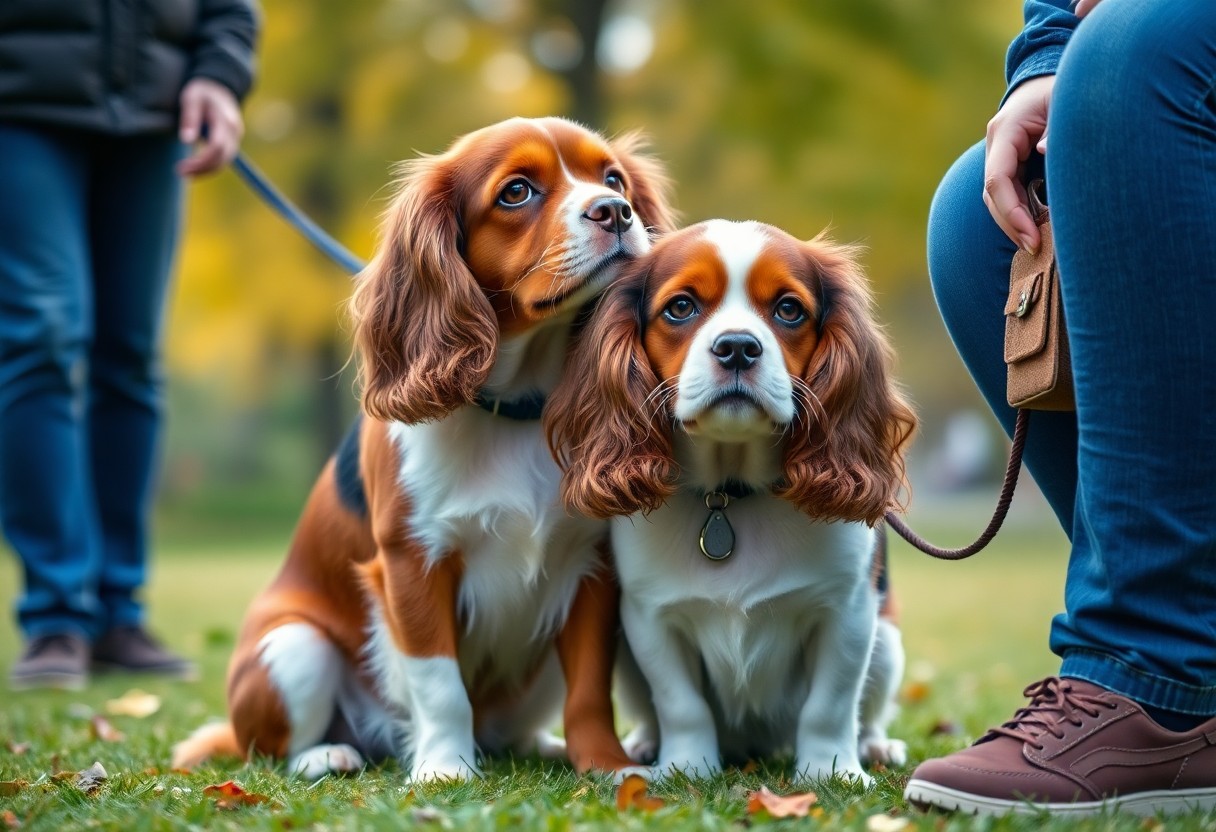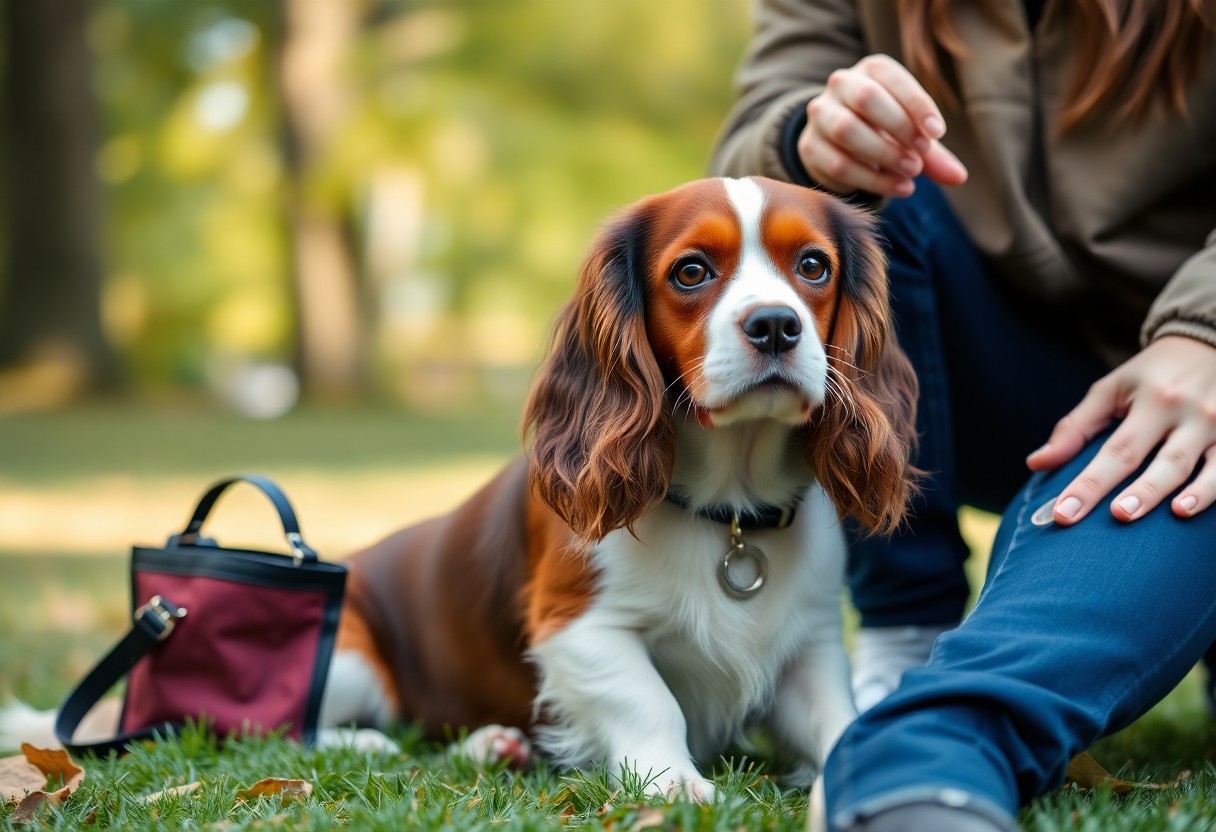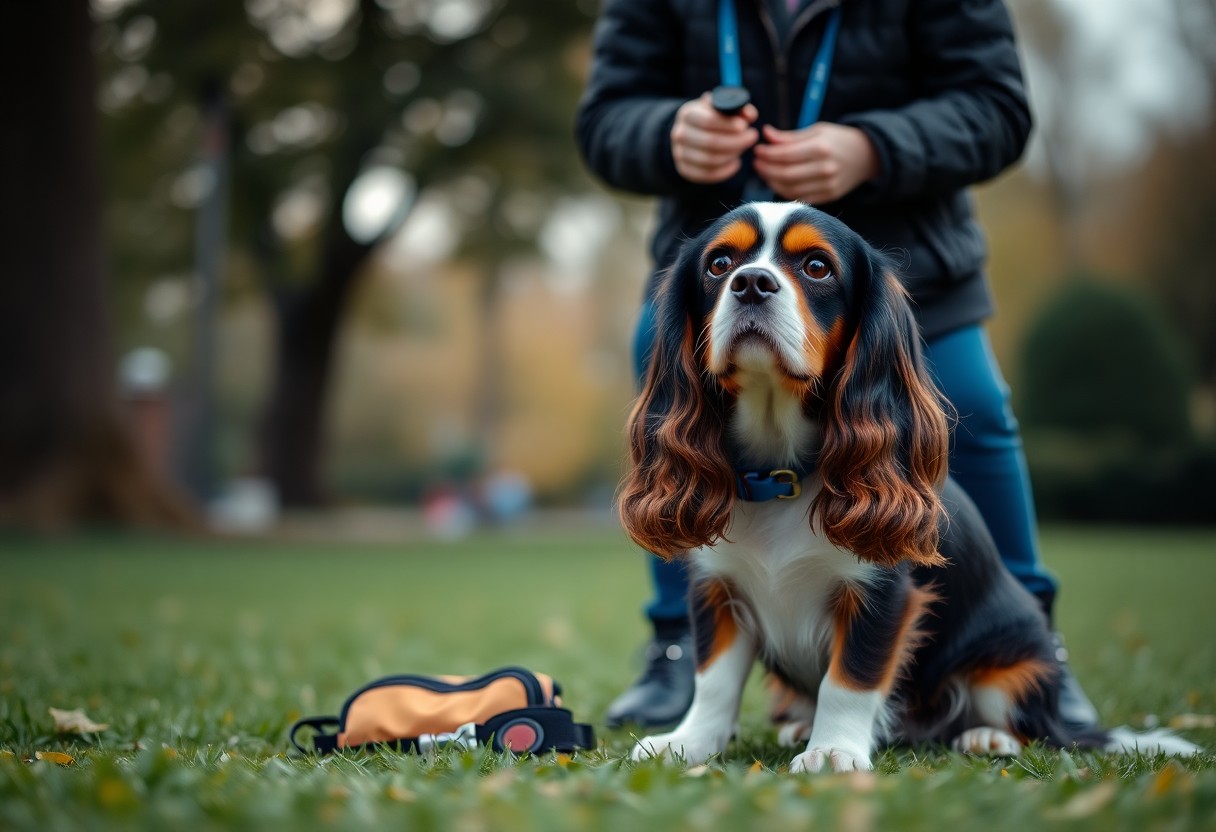Just like any beloved pet, your Cavalier King Charles Spaniel thrives on consistent training to become the well-behaved companion you desire. Whether you are a first-time dog owner or new to this specific breed, it’s important to understand their unique needs. These charming dogs are known for their affectionate nature and eagerness to please, making them ideal for training. In this blog post, you will find vital tips that will help you foster a positive learning environment and strengthen the bond with your furry friend.
Key Takeaways:
- Begin training early to establish good habits and a solid foundation.
- Use positive reinforcement techniques such as treats and praise to encourage desired behaviors.
- Keep training sessions short and engaging to maintain your Cavalier’s attention and enthusiasm.
- Socialize your puppy with various people, pets, and environments to promote confidence and adaptability.
- Be consistent with commands and routines to help your Cavalier understand expectations.
- Practice patience; Cavaliers are eager to please but may take time to learn new skills.
- Incorporate play into training to make learning fun for both you and your dog.
Understanding the Cavalier King Charles Spaniel
The Cavalier King Charles Spaniel is a delightful breed known for its affectionate nature, ideal for families and individuals alike. This breed combines elegance with playfulness, making them perfect companions. With their graceful appearance and lively personality, Cavaliers are eager to please and thrive on human interaction. Understanding their needs and characteristics is necessary for successful training and a happy relationship.
Breed Characteristics
Understanding the breed characteristics of the Cavalier King Charles Spaniel helps you appreciate what makes this dog unique. They typically weigh between 13 to 18 pounds and stand around 12 to 13 inches tall. Their silky, medium-length coat comes in various colors, including Blenheim, tricolor, ruby, and black & tan. This breed is known for its expressive, large eyes and long, floppy ears, contributing to their charming appearance.
Temperament and Behavior
Below the surface, the Cavalier King Charles Spaniel possesses a gentle and friendly temperament. They are incredibly sociable and get along well with children, pets, and strangers alike, making them an excellent family dog. Their eagerness to please makes them highly trainable, but they also require consistent boundaries and positive reinforcement to avoid behavioral issues.
And their friendly nature does come with a few considerations. Cavaliers can become anxious if left alone for extended periods, so it’s vital to foster independence early in training. Additionally, they may inherit certain health issues, such as heart conditions and patellar luxation, making regular veterinary check-ups important. By providing socialization and engaging activities, you can ensure your Cavalier remains happy and well-adjusted throughout their life.
Basic Training Principles
Some necessary training principles help you effectively teach your Cavalier King Charles Spaniel. Understanding these fundamental concepts will set the foundation for a positive training experience. For expert guidance, check out this How to Train a Cavalier King Charles Spaniel: 9 Expert Tips that will assist you in achieving great results.
Positive Reinforcement
With positive reinforcement, you can motivate your Cavalier to learn by rewarding their good behavior with treats, praise, or playtime. This approach helps build a strong bond between you and your dog while making training enjoyable for both of you.
Consistency and Patience
Training your Cavalier requires consistency and patience to be successful. You should establish clear commands and stick with them, ensuring everyone in your household uses the same terminology. Being patient during training sessions fosters a supportive environment where your dog can thrive.
Hence, effective training hinges on your ability to maintain a steady approach and to understand that every dog learns at their own pace. Providing a safe and structured routine can greatly enhance your Cavalier’s understanding of expectations. By approaching each session with a calm mindset and realistic goals, you cultivate a learning atmosphere that encourages growth and reinforces your leadership, ultimately leading to a well-behaved companion.
Essential Commands to Teach
Keep your training sessions focused on important commands that will help create a strong foundation for your Cavalier King Charles Spaniel. Start with basic commands like sit, stay, come, and leave it, which are vital for safety and good behavior. For comprehensive training tips, refer to How to Train Cavalier King Charles Spaniels: 14 Steps.
Sit and Stay
An effective way to begin training is teaching your dog the commands “sit” and “stay.” These commands help establish control and discipline during daily interactions. Start by holding a treat above your dog’s nose to guide them into the sitting position, and once they sit, reward them. To teach “stay,” use a hand signal and step back, rewarding them for staying put.
Come and Leave It
Essential commands like “come” and “leave it” can not only enhance your dog’s training but also protect them from potentially dangerous situations. These commands ensure that your Cavalier responds to your call and avoids unwanted items.
With “come,” practice calling your dog in a cheerful tone, rewarding them immediately when they arrive. For “leave it,” place a treat on the ground and say the command before they reach it. If they obey, reward them with another treat. This command is particularly important for helping your dog avoid harmful objects or substances. Always maintain a positive atmosphere during training sessions, reinforcing desired behaviors with praise and treats to foster a bond of trust and respect.
Socialization Strategies
All Cavalier King Charles Spaniels thrive on social interaction, making effective socialization strategies necessary for happy and well-adjusted pets. Exposing your puppy to a variety of people, environments, and other animals will help them develop confidence and minimize the risk of behavioral issues. Investing time in socialization can lead to a more friendly and adaptable companion, whether you’re out on walks or hosting friends at home.
Importance of Early Socialization
Importance of early socialization cannot be overstated. Introducing your Cavalier to different sights, sounds, and experiences during their formative weeks fosters a foundation for calmness and adaptability in various environments. Early exposure helps prevent future fears and anxieties, ensuring that your furry friend can navigate the world with ease.
Safe Socialization Techniques
With proper socialization techniques, you can create a positive experience for your Cavalier. Start by gradually exposing them to new people and environments in controlled settings. Utilize treats and praise to reinforce good behavior, ensuring that your puppy associates new experiences with positive rewards. Keep interactions short and fun to maintain your dog’s interest without overwhelming them.
Understanding safe socialization techniques means you should prioritize your Cavalier’s comfort. Begin by choosing calm environments where they can meet new people and pets without stress. Introduce them to different surfaces, sounds, and sights, ensuring each experience is positive. Use treats to reward your pup during these encounters, helping them form a positive association with socialization. Monitor their body language for signs of discomfort or fear, and tailor each experience accordingly to avoid negative reactions. Your goal is to build their confidence gradually while making every social interaction enjoyable.
Common Training Challenges
Now, as you begin training your Cavalier King Charles Spaniel, you may encounter common challenges that can test your patience. These can include stubbornness, difficulty focusing, and variations in response to commands. Understanding these challenges is key to developing effective strategies that ensure a smooth training experience. With consistent effort and the right approach, you can help your pup overcome these obstacles and become a well-behaved companion.
Dealing with Distractions
Between the allure of other dogs, people, and interesting smells, your Cavalier may struggle to concentrate during training sessions. To combat distractions, practice in a quiet environment before gradually introducing more stimuli. It’s important to reward your pup for maintaining focus, reinforcing positive behavior when they ignore distractions.
Addressing Behavioral Issues
An important aspect of training involves addressing any behavioral issues that may arise. Whether it’s excessive barking, chewing, or jumping, early intervention is key to resolving these problems. Understanding the underlying causes of these behaviors will enable you to tailor your training approach effectively.
And, by providing consistent structure and positive reinforcement, you can effectively modify unwanted behaviors. Ensure your Cavalier has enough mental and physical stimulation, as boredom often leads to destructive behavior. If barking becomes excessive, redirect this energy through engaging activities, and reinforce calm behavior with praise. Addressing these issues early on can prevent them from becoming a dangerous habit, leading to a harmonious relationship with your furry friend.
Tools and Equipment for Training
For effective training of your Cavalier King Charles Spaniel, having the right tools and equipment is vital. The right gear not only facilitates communication between you and your pup but also ensures a safe and enjoyable learning environment. Consider investing in quality items that cater specifically to the needs of this affectionate breed, enhancing the training experience for both you and your furry companion.
Recommended Training Gear
Along with patience and consistency, having the appropriate training gear can significantly enhance your training sessions. Opt for a durable collar and leash to maintain control during outdoor training, and consider a harness for safe walks. An adjustable training crate can also provide a secure space for your pup while aiding in housebreaking.
Useful Training Resources
Above all the gear, utilizing proper training resources can greatly impact your success. Online courses, training books, or even puppy training apps provide structured methods tailored to your Cavalier’s learning style. With these tools, you can access expert advice and support at your convenience.
Equipment designed for training can make a positive difference in how your Cavalier King Charles Spaniel learns new commands and behaviors. Consider using clickers for positive reinforcement, as they create clear communication between you and your pup. Training pads can assist with housebreaking, while interactive toys can help stimulate their minds during your sessions. Incorporating these vital items will not only help with training but also strengthen the bond between you and your beloved dog.
Summing up
Taking this into account, successful training for your Cavalier King Charles Spaniel begins with establishing a consistent routine and using positive reinforcement techniques. Be patient and keep sessions short and engaging to maintain your dog’s interest. Socializing your pup early on helps develop good behavior around other dogs and people. Always reward desired behaviors with treats or praise to encourage learning. With dedication and the right approach, you’ll foster a strong bond and a well-trained companion that embodies the loving spirit of this adorable breed.
FAQ
Q: What is the best way to start training a Cavalier King Charles Spaniel?
A: The best way to start training your Cavalier King Charles Spaniel is to establish a routine from an early age. Begin with basic commands like sit, stay, and come, using positive reinforcement such as treats, praise, and toys. Short training sessions of about 5-10 minutes are effective, as these dogs have shorter attention spans.
Q: How can I ensure my Cavalier King Charles Spaniel is motivated during training?
A: Motivation can be enhanced by using high-value rewards that your dog finds enjoyable, such as favorite treats or playtime with a cherished toy. Engage with your dog using enthusiastic vocal tones and body language, making the training experience fun and rewarding. Variety in training exercises can also keep their interest alive.
Q: At what age should I start training my Cavalier King Charles Spaniel?
A: Training can begin as early as 8 weeks old. Puppies are generally more receptive to learning and can quickly pick up new commands and socialization skills. Gradual introduction to basic commands and social experiences will help shape their behavior positively as they grow.
Q: Should I focus on socialization as part of my Cavalier training?
A: Yes, socialization is an important aspect of training. Introduce your Cavalier King Charles Spaniel to different people, environments, and other pets to help them grow into well-rounded adults. Positive experiences with varied situations will reduce fearfulness and improve their adaptability.
Q: What common behavioral issues should I look out for, and how can I address them?
A: Common behavioral issues in Cavaliers include excessive barking, separation anxiety, and jumping up. To address these, focus on reinforcing calm behavior and providing distractions like toys when you’re away. Utilize consistent commands and rewards to teach your dog appropriate ways to seek attention without jumping or barking excessively.
Q: How often should I practice training with my Cavalier King Charles Spaniel?
A: Frequent practice is beneficial for reinforcing learning. Incorporate short training sessions several times a day, alongside regular interactions that encourage good behavior. Consistency is key, while also ensuring you keep activities varied and enjoyable to maintain your dog’s enthusiasm for learning.
Q: Should I seek professional help for training my Cavalier King Charles Spaniel?
A: While many owners successfully train their Cavaliers at home, seeking help from a professional dog trainer can be beneficial, especially for first-time dog owners. A professional can offer tailored guidance, address specific behavioral concerns, and help solidify your training techniques effectively.


